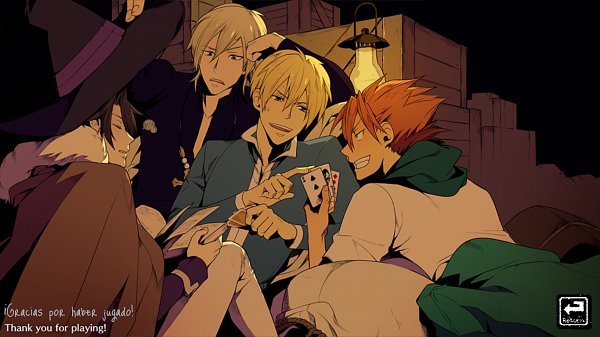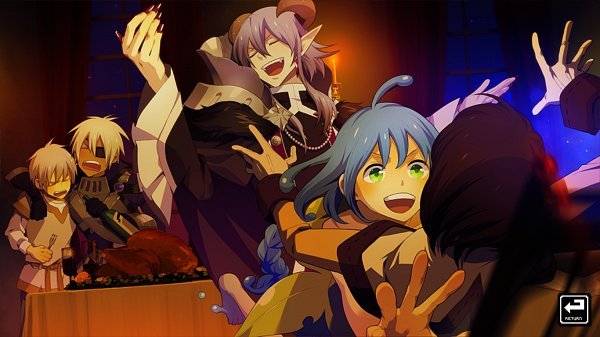What on Earth was the Dot Kareshi ~We’re 8bit Lovers~ trilogy?
The Dot Kareshi trilogy is a series of short otome games created by Diabolik Lovers developer Rejet, originally released in 2013. They’re great entry points for those who are new to the otome genre, and as relaxing, short adventures for veterans to pass the time by with in between lengthier titles.
Just as a warning, however; take note that these games involve some of the most boisterous, confident and handsy love interests I’ve ever seen!
An on the nose, out of this world story
We are the unnameable protagonist: the most literal projection of the player ever seen in an otome game to date. Our heroine used to play an RPG called Ultimate Quest, where she constantly made the wrong decisions and failed miserably at playing.
Despite getting her party members to level 99, she still somehow managed to mess up their stats and got them killed on multiple occasions by choosing to not heal them — and then she just stopped playing, even after achieving such a significant milestone as hitting the level cap. This wouldn’t be too much of an issue… unless, of course, those same party members happened to remember all of this, and were somehow able to teleport her into the game world due to a bug.
And that’s exactly what happens. Clearly hurt by either being forgotten about — or simply resenting her for her past bad decisions in the game — the guys are rubbing their hands together now that they physically have our heroine in their realm. You’ll have to buddy up with one of those team members, survive their quest and get home all in one piece. And you’ll end up quite ruined no matter who you partner up with, because as you’ll come to understand, these boys are desperate for attention and just can’t hold back.

The main appeal of the Dot Kareshi trilogy is not only for the intriguing set-up, beautiful art and the overall sense of polish that fans have come to expect from Rejet, but the voice cast also has many notable famous names in it.
For example, if we just run through the first Dot Kareshi game’s lineup, we have the Hero, voiced by Daisuke Namikawa (Sasazuka Takeru from Collar x Malice and Hugh from Psychedlica of the Ashen Hawk); the Thief, voiced by Shoutaro Morikubo (Yosuke from Persona 4); the Priest, voiced by Masaya Matsukaze (Hagakure Yasuhiro from Danganronpa and Jean Lupin from London Detective Mysteria); and the Magician, voiced by Takashi Kondou (Sakamaki Subaru from Diabolik Lovers and Shiba from EPHEMERAL).
A hands-on approach
For longstanding Rejet fans, it will probably be no surprise to learn how perverted the majority of the Dot Kareshi guys are. No matter how honourable or noble the Hero is, his hot-hotheadedness tends to lead to some pretty spicy conclusions; the Priest is the most verbally suggestive of the lot and despite being too lazy to go out on dates, that never stops him with bedroom activities; the thief is most skilled at stealing your panties; and the Magician uses his magic to take off your clothes and get you into bed. Talk about a diverse cast.
The desperation of the heroes is no different in the sequels. The second Dot Kareshi entry includes the Dancer, Beastmaster, Paladin and Monk. One of them is a yandere, while two are older guys whose sexual frustration is on an even greater scale compared to the other love interests — and one is a masochist due to his maxing out by tanking damage, leading to him deriving pleasure from pain.
While the archetypes are nothing new and are fairly typical for otome game love interests, they make the plot thankfully feel less of a copy-and-paste to its predecessor. The dynamics between the cast members are actually even more humorous and enjoyable than in the first game, in fact, thanks to the archetypes bouncing off one another’s dialogue, setting up jokes undermining the tropes of them, and setting up comical relationships and spats between the guys. The third game then continued to build on this.

The Villager, Slime, Dark Lord and Dark Knight are the love interests in the third Dot Kareshi title, and are categorised as “the evil lot”. It was worth playing all three to discover my best boy of them all: the Dark Knight. His shyness with women was most definitely refreshing as a love interest in the trilogy.
All four love interests in the final entry of the Dot Kareshi series are very entertaining in their own ways, making it probably the most entertaining out of the trilogy as a whole. Ending on the highest note is always impressive!
A laid-back adventure
The Dot Kareshi games are very short, with each clocking in at around 4 hours to fully finish, therefore the whole trilogy can be played to completion in around 12 hours. And since the common route plays out with the same events each time, you can always skip those scenes to get your love interest of choice’s route more quickly. Each route only contains one quest before you get onto the best or normal endings — and it’s interesting to note that these are otome games with no bad endings.
While the games have an overload of sexually charged dialogue and the heroes aggressively pursuing the heroine — all in the name of love, gratification and/or humour, of course — they make it clear that none of them are to be taken too seriously. Each gets to the point — the protagonist bedding your love interest of choice, of course — very quickly, and there’s a lot of comedy centred around RPG tropes.
Dot Kareshi does a wonderful job in parodying the genre. There are a lot of meta jokes, and you’ll often see typical isekai tropes being flipped upside down and unexpectedly poked at for our own amusement — whether it’s the explanations of the various guys’ backstories and their in-game origins, or simply how they play off one another.
Conclusion
If I had one nitpick, it would be with the heroine’s design and characterisation. Her character design masks her face so that she has no eyes visible, no matter how she appears in the CG’s. This is a very well-known and disliked design choice most commonly seen in mobile otome games, but for such short games, it’s not too disappointing here. She has no voiced lines, either, and expresses responses and emotions by indicators such as sweat drops or an angry vein. But there’s an upside: this in turn makes for a lot more voiced lines from those wonderfully illustrated love interests instead.
While we were lucky to see a fan translation of the series appear in 2015, it is unfortunately no longer available. You can still see how it plays, however, since there are translated walkthroughs available on YouTube for each of the entries.
And while the games are delightful, their short run time makes it a shame that we have never see their world or characters expanded upon any further. The series has so much potential; as a series of humorous short adventures, the Dot Kareshi games are a joy to experience for an evening’s worth of gaming. But boy, do I crave more!
Join The Discussion
Rice Digital Discord
Rice Digital Twitter
Rice Digital Facebook
Or write us a letter for the Rice Digital Friday Letters Page by clicking here!
Disclosure: Some links in this article may be affiliate links, which means we may earn a small commission if you make a purchase after clicking on them. This is at no additional cost to you and helps support Rice Digital!
- Sigh of the Abyss: Shadow Bonds – Prologue Review - October 7, 2023
- Is She The Wolf? is wickedly addicting TV - October 6, 2023
- The steady consumption of Slow Damage - October 5, 2023



